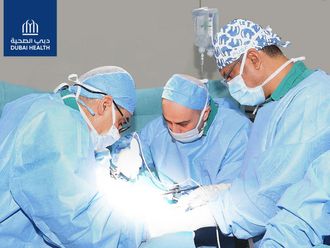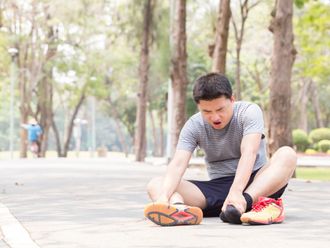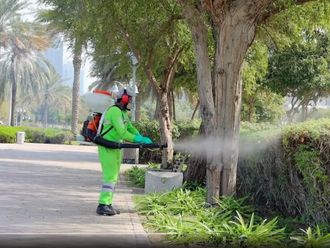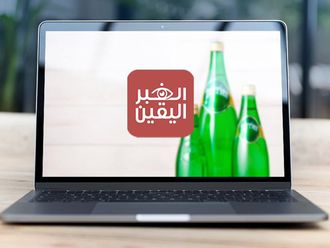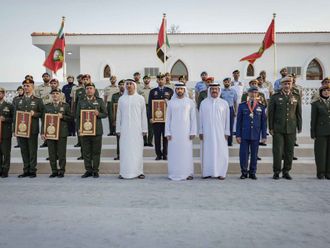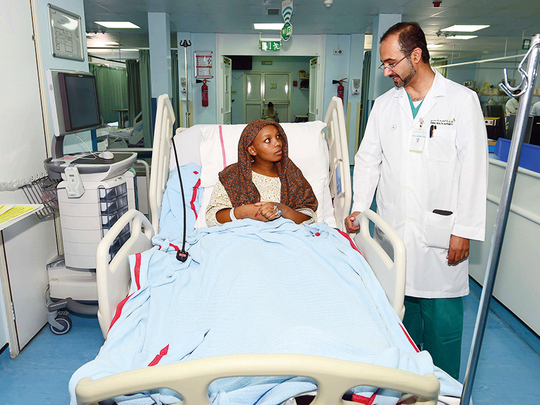
Dubai: When it comes to amputations as a result of road and industrial accidents, highly trained surgeons in the microsurgery section of Rashid Hospital’s trauma department have seen it all.
Every day, these surgeons work round-the-clock to not only reattach severed limbs, but to give a patient the confidence and support to get back to a normal life.
These doctors also have to deal with freak accidents.
Recently, a girl had her finger severed in a bowling alley after she failed to disengage her finger that she had curled into one of the holes of the heavy ball for a better grip. Another person had his thumb severed as he participated in a tug-of-war activity. Then there was the case of a 10-year-old boy whose forefinger got caught in a steel door and had to be amputated.
In another case, a young man had his forearm amputated in a factory accident.
- Dr Khalid Al Awadi | Consultant plastic and hand surgeon
In all cases, timely intervention by surgeons at the microsurgery section not only gave patients back their lost limb, but also restored full functionality to the reattached appendage.
Dr Khalid Abdullah Al Awadi, consultant plastic and hand surgeon, told Gulf News: “When even a finger is accidentally amputated, the individual not only undergoes pain, but loss of quality of life. In case of torn thumbs, the individual loses almost 50 per cent of hand function as most jobs by hand involve the thumb. By reattaching the limb we are able to not only restore the patient’s health, but also give him/her a 100 per cent chance of getting back to his/her job and way of life.”
microsurgeries done at Rashid Hospital in 2017
Opened in 2014, the microsurgery section started with 30 surgeries a month, but now conducts 150. It performed more than 1,650 different types of microsurgeries last year. This year, it conducted more than 25 surgeries, reattaching amputated upper limb portions such as the forearm, complete arm, fingers and thumb.
Dr Al Awadi said: “Our team of eight surgeons specialise in this area and we are available 24/7 for any such emergencies.”
A bouquet of plastic surgery options
Besides the microsurgery, Dr Al Awadi’s team also does muscle flap and skin grafts to restore badly mauled limbs.
“We are on call for different departments such as the cancer ward and other sections of the trauma unit. Recently, I used a part of a lower limb bone to reconstruct the jaw of a patient who had a cancerous tumour in his lower jaw. We also transplanted muscle flap from the back of a male patient to his lower leg where the bone and ligament were exposed following a horrific accident,” he said.
surgeries a month done by microsurgery section
In another case, a 26-year-old Kenyan girl got back her foot thanks to a skin graft.
Purity Warimu, a room attendant at a local hotel in Dubai, was involved in a horrific automobile accident where a car wheel ran over her left foot. She also had severe brain injuries that left her partially paralysed.
Her husband Simon Kamau, 32 who flew down to Dubai to be by her side told Gulf News: “My wife does not remember what or who caused the accident. She does not even remember how long she has been in Dubai. However Dr Al Awadi and his team saved her left foot which would otherwise have been amputated.”
When she was brought to the trauma unit, the skin on Warimu’s left foot had been shorn off, and her muscles and bones were exposed.
“There was little chance of her foot healing without a skin graft. So we used cadaveric human skin [skin of a deceased person] and grafted it on her foot. This was used as a scaffold over which her own skin was grafted. In five days, the cadaveric graft healed after which we put the patient’s own skin and now her foot is healing well. After her head injury treatment, the patient will now be able to use her left foot after rehabilitation and return to a normal life,” Dr Al Awadi said.
Why reattaching amputated limbs is so complex
Treating a simple fracture is different from reattaching a limb because in the latter case, bones, muscles, tendons and ligaments are exposed.
“The minute nerves of the area get damaged and the entire area is avulsed [forcibly detached from its normal position]. We have to not only clean the limb to be attached, but prepare the patient and conduct very minute repairing under the microscope, very often with a suture that is 0.5 millimetres thinner than human hair. That is because sensation is everything. Even if we restore blood circulation, a limb is of no use unless it has full sensation and the damaged nerves are healed. We try and restore 100 per cent quality to the limb so that the patient can live a normal life,” Dr Al Awadi explained.
Explaining the process of reattachment, he said: “Time is of essence as the soft muscle tissue starts necrotising [rotting] within three to four hours. The outer limit is six hours after which it becomes irretrievable. So if a patient suffers an amputation, it is important to get the severed limb as soon as possible — within an hour — to the hospital.”
To save a severed limb, it is important to immediately wash it, clean the tissue, wrap it in a sterile piece of gauze, place it in a sterile bag, seal it and then place this bag in second bag containing chilled water not lower than eight degrees Celsius, the surgeon explained.
“It is important that the severed limb is not directly placed on ice or kept in very cold conditions. The fluids within the limb crystallise in very cold conditions and it makes the limb irretrievable. So it is better to place the sealed bag in a second bag of chilled water,” Dr Al Awadi clarified.
Once the limb arrives, surgeons get to work, cleaning the damaged part, dissecting the tissue to study the extent of damage and nature of vascular repair it will require.
Dr Al Awadi said: “One surgeon gets to work with the amputated limb while another works to prepare the patient. It usually takes between 4-6 hours of microscopic repair and suturing the restore the limb.”
Once the limb is reattached, the patient is required to undergo intensive physiotherapy to regenerate the nerves and muscles and restore full movement.
Once the surgery is done, it takes six to 12 months of intensive rehabilitation and physiotherapy to restore the limb to optimum capacity.


